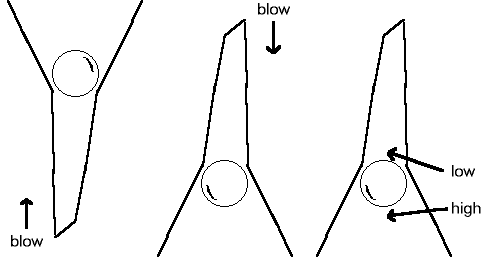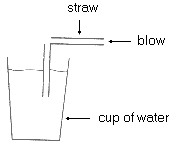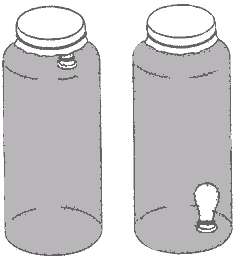
DENSITY AND PRESSURE
Floating Eggsperiment
Place a raw egg in a glass of water and observe. Then add lots of salt to the water and dissolve it. Place the same egg in the glass of salty water.
The egg is denser than fresh water and should sink. When placed in salty water, it should float because the egg is less dense than salt water. Salty water gives the egg more buoyancy. Ships in the ocean also ride higher in the salt water than in fresher river water when they come into port.
Is Diet Softdrink Light
You will need a sink filled nearly to the top with water, a can of Diet softdrink and a can of regular softdrink.
Put both cans of softdrink into the sink filled with water. Which one floats higher in the water than the other?
Because the regular softdrink contains a lot of sugar, it will probably sink. However, the sweetener in the Diet softdrink (possibly aspartane) is only in very small amounts because it has 200 times the sweetness of ordinary sugar. The Diet softdrink will float higher in the sink.
Lava Lamp
You will need a clear jar, oil, salt and water.
Half-fill the clear jar with water. Pour a generous amount of oil on top (about 1 cm). Now sprinkle a generous amount of salt on top of the oil and watch.
The salt will become coated with oil and will sink because the combination is denser. Then as the oil separates from the salt, the oil will float back up again as oil alone is less dense than water.
Floating Fruit
- Safety Rules:
- Parent supervision
- Take care with a knife
- Materials you need are:
- an orange with a thick peel
- a knife
- a container of water
Before peeling the orange, put it in water. It should float. Now peel the orange and observe if the peeled orange and the separate peel float or sink. The peeled orange should sink, and the peel should float.
Because the peel is less dense than water, both the peel alone and the unpeeled orange float. However, the peeled orange is more dense than water and sinks.
Do Hot and Cold Water Mix
- Safety Rules:
- Parent supervision
- Take care with fire or heat
- Materials you need are:
- 2 containers with the same-sized openings
- hot water
- cold water with icecubes
- 2 sheets of waxed paper
- red and blue food colouring
- a sink
- a friend or a parent
- gloves
Completely fill to the brim one container with cold water and add a few drops of blue food colouring. Cover it with waxed paper. Also fill to the brim the second container with hot water and add a few drops of red food colouring. Cover it with waxed paper. Now comes the tricky part. With help from your parent, turn the covered hot water container upside-down to fit exactly over the top of the cold water container. Remove both waxed paper sheets and observe any colour mixing.
If you've done this tricky experiment properly, the hot and cold waters should not mix. Cold water is denser than hot water which is lighter, so the coldwater should stay at the bottom and the hot water should stay at the top.
Popping Straws
You will need a few drinking straws and a friend. You also may need to practise a few times for this to work.
Twist the ends of one drinking straw tightly but in different directions so that you trap air in the straw. Keep twisting until you can't any more. Get your friend to flick the middle of the inflated straw with one hard flick. It should burst loudly.
By twisting the air inside the straw into a smaller volume, you have increased the pressure. Only a small amount of force will be needed to burst the straw.
Fascinating Funnel
You will need a funnel and a ping-pong ball. Place the ball in the funnel and hold it in place with your hand. Turn the whole lot upside down and blow through the small spout of the funnel. While blowing, remove your hand.

The ball should stay suspended inside the funnel. This demonstrates Bernoulli's Principle about air pressure. As the air is blown down the spout, it comes to the cone of the funnel. The air spreads out into the larger area and the pressure drops. This creates a lower air pressure which 'sucks' the ball in the cone, and the outside air is of a higher pressure and 'pushes' the ball into the cone.
Magic Ping-pong Ball
You will need one ping-pong ball, a piece of cotton thread (about 75cm long) and a water tap.
Tie the thread around the ball. Turn on the water tap. Suspend the ball close to but not touching the water, and watch.
The ball should be drawn towards the water while the tap is running. The stream of water carries with it some of the surrounding air. When the ball is brought close enough, the moving air on the tap side produces a low air pressure zone, while on the other side of the ball, the air pressure is higher. This causes the ball to be 'sucked' towards the water.
Magic Straws
You will need 2 drinking straws, sticky tape and a glass of water.
Fill a glass of water. Place the drinking straws at right angles to each other and hold them with a small piece of sticky tape. Put one end of one drinking straw in your mouth and the other end of the other drinking straw in the glass of water. Blow hard.

For this to work, the straws must be at exactly 90 degrees. Using the Bernoulli Principle, as you blow through the top straw, the air pressure is reduced just above the open end of the bottom straw.
Make a Curved Wing
Hold a strip of paper (about 20 cm long and about 5 cm wide) just below your lips. Blow over the top of the paper. What happens?
The strip of paper is like the wing of an aircraft. As air is blown over the top of the paper strip at a faster speed than the air moving beneath it, this creates a lower pressure above the wing than beneath it. This creates 'lift' and the paper strip should rise up. The faster you blow, the more lift there is.
Egg in a Bottle
- Safety Rules:
- Parent supervision
- Take care with fire or heat
- Materials you need are:
- a peeled soft-boiled egg
- a glass bottle with an opening slightly smaller than the peeled egg
- a piece of rolled-up paper
- matches
Light the rolled up piece of paper and throw it into the bottle. After the paper has been burning for a few seconds, place the peeled soft-boiled egg into the neck of the bottle (sharp pointed end downwards).
The egg should be 'sucked' into the bottle. The burning paper uses up some of the oxygen in the bottle so there is less air in the bottle. This causes less air pressure in the bottle compared with the outside air so the egg is 'sucked' into the bottle.
Cartesian Diver
- Materials you need are:
- a large clear jar with a fairly wide opening
- a balloon (the round type) or a sheet of rubber and a strong elastic band
- a sweets wrapper that just barely floats in water to be the 'diver'
-

Fill the jar to the brim with water. Put the sweets wrapper into the jar. Cover the opening tightly with a balloon. Press on the balloon and the 'diver' (the sweets wrapper) should sink. When you take your hand away and release the pressure, the 'diver' should rise up again.
As you press down on the rubber sheet, the pressure inside the container increases and the 'diver' is forced downward. Try other 'divers' such as small screwtop vials with small amounts of water.
Poke a Potato with a Straw
You will need a potato and a drinking straw.
Hold the straw and put your finger over one end to make it airtight. Punch the other end into the potato. It should pierce through the skin.
By covering one end of the straw, you have trapped some air in the straw. When punch into the potato, this air provides sufficient pressure to drive the straw through the skin.
Make a Sucker out of Someone
- Safety Rules:
- Parent supervision
- Take care with a knife
- Materials you need are:
- a clear jar with a lid that fits tightly
- a drinking straw
- a sharp knife
- plasticine or Blu-tak
- water
Fill the jar with water. Cut a hole in the lid just large enough to fit the straw through. Put the straw through and seal it with plasticine so that it is completely airtight. Ask a friend to suck the water through the straw.
Normally as you suck through a straw, you reduce the air pressure inside your mouth and it will be less than the air pressure in the room. This allows the water in a glass to be moved the straw into your mouth.
However, by sealing the lid, no air from the room can force the water up the straw into your friend's mouth. No matter how hard your friend tries, he/she will not be able to suck the water.
Make a Siphon
- Materials you need are:
- a sink nearly full of water
- 2 large clear jars that can fit into the sink
- a length of plastic tubing
Fill the two large jars with water. Hold some plastic tubing under water until it is completely filled with water. Put your fingers tightly over both ends of the tubing. Then one end under water into each of the jars. Lift one jar up above the other. Water should flow from one jar into the other.
The water is being siphoned by air pressure and gravity from one jar to the other.
Water Pressure at Different Depths
- Safety rules:
- Parent supervision
- Take care with hammer and nails
- Materials you need are:
- an old tin
- a hammer
- a nail
- water
Hammer 3 holes above one another into the side of the tin. Fill it with water and observe the water jets.
The greatest water jet is at from the bottom hole where the water pressure due to the weight of water above is the greatest. The top hole has the weakest water jet.
Plasticine Boat
You will need lots of plasticine, a large container of water and some small rocks as weights.
Your task is to make a boat out of plasticine that will carry as much weight as possible without sinking. Try different shapes for the hull.